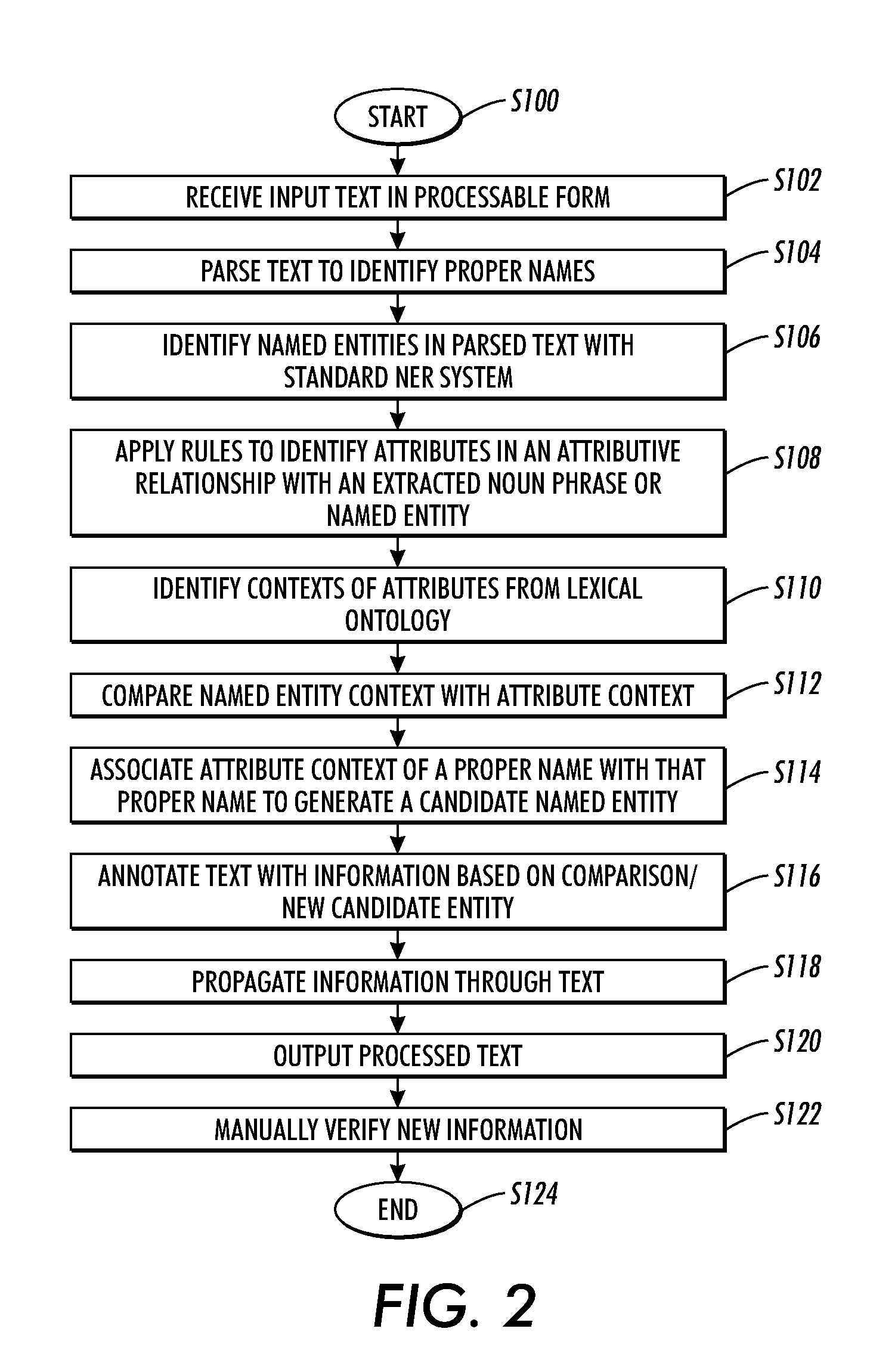Semantic compatibility checking for automatic correction and discovery of named entities
a technology of automatic correction and discovery, applied in the field of text processing, can solve the problems of tedious task, invariably error-free, and difficult automatic recognition of named entities in text, and achieve the effect of not invariably free of errors, tedious task, and inability to automatically recognize named entities in tex
- Summary
- Abstract
- Description
- Claims
- Application Information
AI Technical Summary
Problems solved by technology
Method used
Image
Examples
example 1
XIP-Based Prototype
[0125]In order to demonstrate the applicability of the system 12, a prototype was built that makes use of the XIP engine (discussed in Aït-Mokhtar 2002) and normalization grammar, coupled with information gathered from the WordNet lexical ontology. See Hagège C., Roux C., Entre syntaxe et sémantique: Normalisation de l'analyse syntaxique en vue de l'amélioration de l'extraction d'information. Proc. TALN 2003, Batz-sur-Mer, France (2003) for a fuller description of the normalization grammar rules applied by the system.
[0126]The XIP normalization grammar, as adapted to the present system 12, extracts deep syntactic relations, among which the attributive relation. For the prototype, attributive relations in XIP correspond to syntactic subject complement, nominal apposition, and even expression of beliefs. All these syntactic links correspond, as discussed above to a semantic ISA relation. Since a dependency parser is used, even long distance attributive relations can...
example 2
General Domain Corpus
[0142]A large corpus of political news of 426 Megabytes was used for this example. The exemplary method was applied to this corpus. The classical NER system 16, which is first applied to the text, is designed to recognize five named entity contexts: LOCATION, ORGANIZATION, EVENT, PERSON and DATES. This particular NER system 16 has been previously evaluated (see Maud Ehrmann. Evaluation d'un Système d'extraction d'Entités Nommées. Rapport de stage DESS Texte, Nancy (2004)). It generally performs with a precision of 90.5% and a recall of 89%. Precision is the number of correct named entities identified by the system over the number of entities identified by the system Recall is the number of correct named entities identified by the system over the total number of entities present in the corpus. Together with this classical NER 16, the specific attributive grammar 56 is applied and semantic type checking on the NEs is then performed. The type checking involved 81,8...
example 3
Biological Corpus
[0148]The system 12 was applied to a large biological corpus. The system extracts 1931 entities, where 1824 are discovered (TYPE DISCOVER) and 107 are in conflict (TYPE CONFLICT) with the output of the standard NER system 16. No entities have been found compatible. An illustration is given below:
(1) Metallothionein (MT) is a ubiquitous, metal-inducibleprotein with an important role in the homeostasis and inthe detoxification of heavy metals.ATTRIB(Metallothionein,protein)ENTITY(Metallothionein,protein)DISCOVERY_SUBSTANCE(protein,Metallothionein+proper)0>TOP{SC{NP{Metallothionein) INS{( NP{MT) )} FV{is}}NP{a AP{ubiquitous} , AP{ADJ{metal - inducible}} protein}PP{with NP{an AP{important} role}} PP{in NP{thehomeostasis}} and PP{in NP{the detoxification}} PP{ofNP{heavy metals}} .}
[0149]In the above example, Metallothionein is discovered as a SUBSTANCE by the prototype checking system 12.
(2) NixA, a high-affinity nickel transport protein,allows synthesis of catalytically...
PUM
 Login to View More
Login to View More Abstract
Description
Claims
Application Information
 Login to View More
Login to View More - R&D
- Intellectual Property
- Life Sciences
- Materials
- Tech Scout
- Unparalleled Data Quality
- Higher Quality Content
- 60% Fewer Hallucinations
Browse by: Latest US Patents, China's latest patents, Technical Efficacy Thesaurus, Application Domain, Technology Topic, Popular Technical Reports.
© 2025 PatSnap. All rights reserved.Legal|Privacy policy|Modern Slavery Act Transparency Statement|Sitemap|About US| Contact US: help@patsnap.com



